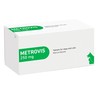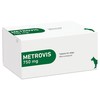Metrovis
Metrovis Tablets are used for the treatment of infections of the urogenital tract, oral cavity, throat, and skin caused by obligate anaerobic bacterial susceptible to metronidazole. They can also be used for the treatment of gastrointestinal tract infections caused by Giardia spp. and Clostridia spp.
Metrovis Tablets are presented as round, beige coloured tablets with a cross-shaped break line on one side. They can be divided into 2 or 4 equal parts for easy and accurate dosing.
Metrovis 250mg Tablets for Dogs and Cats
£0.22Metrovis 250mg Tablets are indicated for the treatment of gastrointestinal tract infections caused by Giardia spp. and Clostridia spp. Metrovis can also be used for the treatment of...[More info]
Metrovis 750mg Tablets for Dogs and Cats
£0.59Metrovis 750mg Tablets are indicated for the treatment of gastrointestinal tract infections caused by Giardia spp. and Clostridia spp. Metrovis can also be used for the treatment of...[More info]
Metrovis 100mg Tablets for Dogs and Cats
£0.17Metrovis 100mg Tablets are indicated for the treatment of gastrointestinal tract infections caused by Giardia spp. and Clostridia spp. Metrovis can also be used for the treatment of...[More info]
Contraindications
Do not use in case of hepatic disorders.
Do not use in case of hypersensitivity to the active substance or to any of the excipients.
Special warnings for each target species
None.
Special precautions for use
Special precautions for use in animals
Due to the likely variability (time, geographical) in the occurrence of metronidazole resistant bacteria, bacteriological sampling and susceptibility testing are recommended.
Whenever possible, the product should only be used based on susceptibility testing.
Official, national and regional antimicrobial policies should be taken into account when the veterinary medicinal product is used.
In very rare cases, neurological signs may occur especially after prolonged treatment with metronidazole.
Special precautions to be taken by the person administering the veterinary medicinal product to animals
Metronidazole has confirmed mutagenic and genotoxic properties in laboratory animals as well as in humans. Metronidazole is a confirmed carcinogen in laboratory animals and has possible carcinogenic effects in humans. However, there is inadequate evidence in humans for the carcinogenicity of metronidazole.
Metronidazole may be harmful for the unborn child.
Impervious gloves should be worn during administration of the product to avoid skin contact with the product.
To avoid accidental ingestion, particularly by a child, unused tablets and part-tablets should be returned to the open blister space, inserted back into the outer packaging and kept in a safe place out of the sight and reach of children. In case of accidental ingestion, seek medical advice immediately and show the package leaflet or the label to the physician. Wash hands thoroughly after handling the tablets.
Metronidazole may cause hypersensitivity reactions. In case of known hypersensitivity to metronidazole, avoid contact with the veterinary medicinal product.
Adverse reactions (frequency and seriousness)
The following adverse reactions may occur after administration of metronidazole: vomiting, hepatotoxicity, neutropenia and neurological signs.
The frequency of adverse reactions is defined using the following convention:
- very common (more than 1 in 10 animals treated displaying adverse reaction(s))
- common (more than 1 but less than 10 animals in 100 animals treated)
- uncommon (more than 1 but less than 10 animals in 1,000 animals treated)
- rare (more than 1 but less than 10 animals in 10,000 animals treated)
- very rare (less than 1 animal in 10,000 animals treated, including isolated reports).
Use during pregnancy, lactation or lay
Pregnancy:
Studies in laboratory animals have shown inconsistent results with regard to teratogenic/embryotoxic effects of metronidazole. Therefore, the use of this product during pregnancy is not recommended.
Lactation:
Metronidazole is excreted in milk and use during lactation is therefore not recommended.
Interaction with other medicinal products and other forms of interaction
Metronidazole may have an inhibitory effect on the degradation of other drugs in the liver, such as phenytoin, cyclosporine and warfarin.
Cimetidine may decrease the hepatic metabolism of metronidazole resulting in increased serum concentration of metronidazole. Phenobarbital may increase hepatic metabolism of metronidazole resulting in decreased serum concentration of metronidazole.
Amounts to be administered and administration route
For oral use.
The recommended dose is 50 mg metronidazole per kg bodyweight per day, for 5-7 days. The daily dose may be split into two administrations per day (i.e. 25mg/kg bodyweight twice daily). To ensure administration of the correct dosage, bodyweight should be determined as accurately as possible. The following table is intended as a guide to dispensing the product at the recommended dose rate of either 50 mg per kg bodyweight, administered once daily or, preferably, administered twice daily in 25 mg per kg bodyweight.
Tablets can be divided into 2 or 4 equal parts to ensure accurate dosing. Place the tablet on a flat surface, with its scored side facing up and the convex (rounded) side facing the surface.
Halves: press down with your thumbs on both sides of the tablet.
Quarters: press down with your thumb in the middle of the tablet.
Overdose (symptoms, emergency procedures, antidotes), if necessary
Adverse events are more likely to occur at doses and treatment durations in excess of the recommended treatment regimen. If neurologic signs occur, treatment should be discontinued, and the patient should be treated symptomatically.
Withdrawal period(s)
Not applicable


